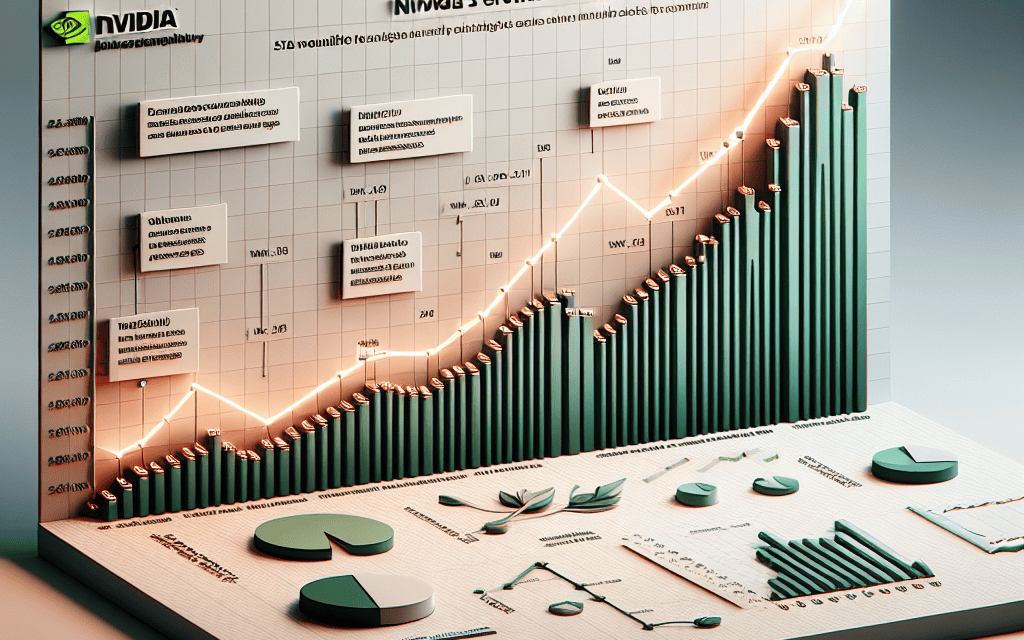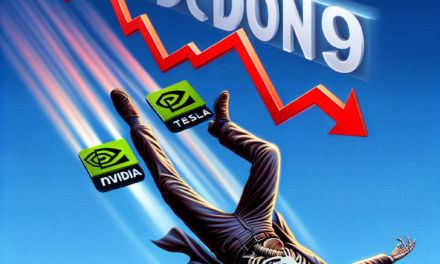“Propelling Innovation: Nvidia’s Blackwell Six Months On”
Introduction
Nvidia’s trajectory in the six months following the launch of its Blackwell architecture has been marked by significant advancements and strategic maneuvers that have further solidified its position as a leader in the semiconductor industry. The Blackwell architecture, named after the renowned mathematician David Blackwell, represents a leap forward in GPU technology, offering unprecedented performance and efficiency improvements. This period has seen Nvidia not only capitalize on the technological prowess of Blackwell but also expand its influence across various sectors, including gaming, data centers, and AI-driven applications. The company’s focus on innovation and strategic partnerships has enabled it to address the growing demands of high-performance computing and artificial intelligence, while also navigating the challenges of supply chain constraints and competitive pressures. As Nvidia continues to push the boundaries of what’s possible with its cutting-edge technology, its trajectory post-Blackwell launch underscores a commitment to shaping the future of computing.
Blackwell’s Impact on Nvidia’s Market Position
Six months have passed since Nvidia’s much-anticipated launch of the Blackwell architecture, a pivotal moment that has significantly influenced the company’s market position. This period has provided ample time to assess the impact of Blackwell on Nvidia’s standing in the competitive landscape of semiconductor technology. As the dust settles, it becomes increasingly clear that Blackwell has not only reinforced Nvidia’s dominance but also set new benchmarks in the industry.
To begin with, the Blackwell architecture has been lauded for its groundbreaking advancements in performance and efficiency. By integrating cutting-edge technologies, Nvidia has managed to deliver a product that significantly outperforms its predecessors. This leap in capability has been particularly evident in the realm of artificial intelligence and machine learning, where Blackwell’s enhanced processing power and energy efficiency have enabled faster and more complex computations. Consequently, Nvidia has solidified its reputation as a leader in AI hardware, a sector that continues to expand rapidly.
Moreover, the launch of Blackwell has had a profound effect on Nvidia’s financial performance. The architecture’s superior capabilities have driven a surge in demand across various industries, from gaming to data centers. This increased demand has translated into robust sales figures, bolstering Nvidia’s revenue and market share. In turn, the company’s stock price has experienced a notable uptick, reflecting investor confidence in Nvidia’s strategic direction and its ability to innovate continuously.
In addition to financial gains, Blackwell has also strengthened Nvidia’s strategic partnerships. By offering a product that meets the evolving needs of its partners, Nvidia has deepened its collaborations with key players in the tech industry. These partnerships have not only facilitated the integration of Blackwell into a wide array of applications but have also opened new avenues for joint innovation. As a result, Nvidia has fortified its ecosystem, creating a network of alliances that further cements its market position.
Furthermore, the competitive landscape has been reshaped by Blackwell’s introduction. Rivals in the semiconductor industry have been compelled to accelerate their own research and development efforts in response to Nvidia’s advancements. This competitive pressure has spurred a wave of innovation, benefiting the industry as a whole. However, Nvidia’s head start with Blackwell has given it a distinct advantage, allowing the company to maintain a leadership position while others strive to catch up.
Despite these successes, Nvidia faces challenges that could impact its future trajectory. The rapid pace of technological change necessitates continuous innovation, and Nvidia must remain vigilant to maintain its competitive edge. Additionally, geopolitical tensions and supply chain disruptions pose potential risks that could affect the availability and cost of critical components. Navigating these challenges will require strategic foresight and adaptability.
In conclusion, the launch of the Blackwell architecture has had a transformative impact on Nvidia’s market position. By delivering unprecedented performance and efficiency, Blackwell has reinforced Nvidia’s dominance in the semiconductor industry and driven significant financial gains. The architecture has also strengthened strategic partnerships and reshaped the competitive landscape. However, as Nvidia looks to the future, it must remain agile in the face of evolving challenges to sustain its trajectory of success. As the industry continues to evolve, Nvidia’s ability to innovate and adapt will be crucial in maintaining its leadership position.
Technological Advancements in Blackwell Architecture
Six months have passed since Nvidia unveiled its groundbreaking Blackwell architecture, marking a significant milestone in the evolution of graphics processing technology. This period has provided ample time to assess the impact and advancements brought about by this new architecture. As we delve into the technological advancements of Blackwell, it is essential to consider the broader implications for both the industry and consumers.
The Blackwell architecture represents a leap forward in computational power and efficiency, building upon the successes of its predecessor, the Hopper architecture. One of the most notable advancements is the enhanced parallel processing capabilities, which have been achieved through a refined chip design and improved transistor density. This has allowed Nvidia to deliver unprecedented levels of performance, catering to the ever-increasing demands of modern applications, from gaming to artificial intelligence.
Moreover, the Blackwell architecture introduces a new level of energy efficiency, a critical factor in today’s environmentally conscious world. By optimizing power consumption without compromising performance, Nvidia has set a new standard for sustainable computing. This achievement is particularly significant as it aligns with global efforts to reduce carbon footprints and promote green technology. Consequently, the Blackwell architecture not only enhances performance but also contributes to a more sustainable future.
In addition to these improvements, Blackwell has also made strides in memory management. The integration of advanced memory technologies has resulted in faster data access and reduced latency, which are crucial for high-performance computing tasks. This development is particularly beneficial for industries that rely on real-time data processing, such as autonomous vehicles and financial modeling. By addressing memory bottlenecks, Nvidia has enabled smoother and more efficient operations across various sectors.
Furthermore, the Blackwell architecture has expanded its support for machine learning and artificial intelligence applications. With the inclusion of specialized cores designed for AI workloads, Nvidia has positioned itself as a leader in the AI revolution. These cores facilitate faster training and inference processes, empowering developers to create more sophisticated models and applications. As AI continues to permeate various aspects of our lives, the advancements in Blackwell architecture are poised to accelerate innovation and drive progress in this field.
Transitioning to the consumer perspective, the Blackwell architecture has also had a profound impact on the gaming industry. Gamers have experienced a new level of realism and immersion, thanks to the enhanced graphics capabilities and ray tracing support. The ability to render lifelike environments and characters in real-time has redefined the gaming experience, setting a new benchmark for visual fidelity. This has not only delighted gamers but also inspired game developers to push the boundaries of creativity and storytelling.
In conclusion, the six months following the launch of Nvidia’s Blackwell architecture have demonstrated its transformative potential across multiple domains. By delivering superior performance, energy efficiency, and support for emerging technologies, Blackwell has solidified Nvidia’s position as a leader in the tech industry. As we look to the future, it is clear that the advancements in Blackwell architecture will continue to shape the landscape of computing, driving innovation and enabling new possibilities for both businesses and consumers alike.
Nvidia’s Strategic Partnerships Post-Blackwell
Six months have passed since Nvidia’s groundbreaking launch of the Blackwell architecture, a pivotal moment that has significantly influenced the company’s strategic direction. This period has been marked by a series of strategic partnerships that underscore Nvidia’s commitment to maintaining its leadership in the semiconductor industry. These alliances are not only enhancing Nvidia’s technological capabilities but also expanding its reach into new markets, thereby solidifying its position as a key player in the global tech landscape.
To begin with, Nvidia’s collaboration with leading cloud service providers has been a cornerstone of its post-Blackwell strategy. By partnering with giants such as Amazon Web Services, Microsoft Azure, and Google Cloud, Nvidia has ensured that its cutting-edge GPUs are seamlessly integrated into the cloud infrastructure. This integration allows for enhanced performance in data centers, enabling faster processing of complex workloads and supporting the growing demand for artificial intelligence and machine learning applications. Consequently, these partnerships have not only bolstered Nvidia’s presence in the cloud computing sector but have also driven significant revenue growth.
In addition to cloud partnerships, Nvidia has strategically aligned itself with key players in the automotive industry. The Blackwell architecture’s advanced capabilities have made it an attractive choice for companies developing autonomous vehicle technologies. Collaborations with automotive leaders such as Tesla and Mercedes-Benz have allowed Nvidia to provide the computational power necessary for the development of sophisticated driver-assistance systems and fully autonomous vehicles. These partnerships are instrumental in Nvidia’s strategy to capture a significant share of the burgeoning autonomous vehicle market, which is expected to grow exponentially in the coming years.
Moreover, Nvidia’s strategic partnerships extend to the realm of gaming, a sector where the company has long been a dominant force. By working closely with game developers and console manufacturers, Nvidia has ensured that its GPUs remain at the forefront of gaming technology. The Blackwell architecture’s enhanced graphics capabilities have been leveraged to deliver more immersive and realistic gaming experiences, thereby maintaining Nvidia’s competitive edge in this highly lucrative market. Furthermore, collaborations with companies like Sony and Microsoft have facilitated the integration of Nvidia’s technology into next-generation gaming consoles, further cementing its influence in the gaming industry.
Beyond these sectors, Nvidia has also ventured into the realm of healthcare through strategic partnerships aimed at revolutionizing medical imaging and diagnostics. By collaborating with healthcare technology companies, Nvidia is harnessing the power of the Blackwell architecture to accelerate the processing of medical data, enabling faster and more accurate diagnoses. This move not only highlights Nvidia’s versatility but also its commitment to leveraging its technology for societal benefit.
In conclusion, Nvidia’s strategic partnerships post-Blackwell launch have been instrumental in shaping the company’s trajectory. By aligning with key players across various industries, Nvidia has not only expanded its market reach but also reinforced its position as a leader in technological innovation. These alliances have enabled Nvidia to capitalize on emerging opportunities, ensuring sustained growth and continued relevance in an ever-evolving tech landscape. As Nvidia continues to forge new partnerships and explore untapped markets, its strategic vision remains clear: to drive technological advancement and create value across diverse sectors.
Blackwell’s Influence on AI and Machine Learning

Six months have passed since Nvidia’s much-anticipated Blackwell architecture made its debut, marking a significant milestone in the evolution of artificial intelligence and machine learning technologies. As the dust begins to settle, the influence of Blackwell on these fields is becoming increasingly apparent. This new architecture, named after the renowned statistician David Blackwell, has introduced a suite of advancements that are reshaping the landscape of AI and machine learning, offering both opportunities and challenges to researchers and developers alike.
To begin with, Blackwell’s architecture has significantly enhanced computational efficiency, a critical factor in the development and deployment of AI models. By leveraging a more refined chip design and improved parallel processing capabilities, Nvidia has managed to reduce latency and increase throughput. This has allowed for faster training times and more efficient inference processes, which are crucial for the deployment of AI models in real-time applications. Consequently, industries that rely heavily on AI, such as autonomous vehicles, healthcare diagnostics, and financial services, are experiencing a surge in innovation and productivity.
Moreover, the Blackwell architecture has introduced new levels of scalability, enabling researchers to tackle more complex problems with larger datasets. This scalability is particularly beneficial in the realm of deep learning, where the size and complexity of models have been growing exponentially. With Blackwell, developers can now train models that were previously deemed too resource-intensive, opening the door to breakthroughs in areas such as natural language processing and computer vision. The ability to handle larger datasets with ease also means that AI models can be trained on more diverse data, leading to improved accuracy and generalization.
In addition to these technical advancements, Blackwell has also had a profound impact on the democratization of AI technology. By making high-performance computing more accessible, Nvidia is empowering smaller companies and research institutions to compete with larger entities that have traditionally dominated the field. This democratization is fostering a more diverse and competitive ecosystem, which is essential for driving innovation and ensuring that AI technologies are developed in a manner that is inclusive and equitable.
However, the rapid adoption of Blackwell has not been without its challenges. The increased computational power and efficiency have led to a surge in demand for Nvidia’s hardware, resulting in supply chain constraints and increased costs for end-users. This has raised concerns about the sustainability of such rapid technological advancements and the potential for market monopolization. Furthermore, as AI models become more powerful, ethical considerations surrounding their use and potential biases have come to the forefront. It is imperative that the AI community addresses these issues to ensure that the benefits of Blackwell’s advancements are realized in a responsible and ethical manner.
In conclusion, Nvidia’s Blackwell architecture has undeniably set a new benchmark in the fields of AI and machine learning. Its influence is evident in the enhanced computational efficiency, scalability, and democratization of AI technologies. While challenges remain, particularly in terms of supply chain constraints and ethical considerations, the potential for innovation and progress is immense. As researchers and developers continue to explore the capabilities of Blackwell, it is clear that this architecture will play a pivotal role in shaping the future of AI and machine learning for years to come.
Consumer Reception and Feedback on Blackwell
Six months have passed since Nvidia’s much-anticipated Blackwell architecture made its debut, and the consumer reception has been a topic of considerable interest within the tech community. As the dust begins to settle, it is becoming increasingly clear how Blackwell is being perceived by both enthusiasts and everyday users. Initially, the launch was met with a wave of excitement, driven by Nvidia’s reputation for pushing the boundaries of graphics technology. The promise of enhanced performance, improved energy efficiency, and cutting-edge features set high expectations among consumers.
In the early days following the release, feedback was overwhelmingly positive, with many users praising the significant leap in performance compared to previous generations. Gamers, in particular, noted the remarkable improvements in frame rates and graphical fidelity, which translated into a more immersive experience. This was especially evident in graphically demanding titles, where Blackwell’s capabilities allowed for higher resolutions and more detailed textures without compromising on performance. Moreover, content creators found the new architecture to be a boon for their workflows, as rendering times were noticeably reduced, allowing for more efficient project completion.
However, as the initial excitement began to wane, more nuanced feedback emerged. Some consumers expressed concerns regarding the pricing of Blackwell-based products, which, while justified by the technological advancements, posed a barrier for budget-conscious buyers. This sentiment was echoed by those who felt that the incremental benefits did not necessarily justify the premium price tag, especially for users who did not require the full extent of Blackwell’s capabilities. Consequently, Nvidia faced the challenge of balancing innovation with accessibility, a task that remains ongoing.
In addition to pricing concerns, there were discussions about the availability of Blackwell products. Supply chain issues, a common theme in the tech industry, affected the initial rollout, leading to frustration among consumers eager to upgrade. Nvidia has since made strides in addressing these issues, but the initial scarcity left a lasting impression on some potential buyers. Despite these challenges, Nvidia’s customer support and communication efforts have been generally well-received, with many consumers appreciating the transparency and responsiveness demonstrated by the company.
Furthermore, the environmental impact of Blackwell has been a point of discussion among eco-conscious consumers. Nvidia’s commitment to improving energy efficiency was a welcome development, as it aligns with broader industry trends towards sustainability. The reduced power consumption of Blackwell-based products not only benefits the environment but also translates into cost savings for users over time. This aspect has been particularly appealing to those who prioritize eco-friendly technology solutions.
Looking ahead, Nvidia’s trajectory with Blackwell appears promising, as the company continues to refine and expand its offerings. The feedback gathered over the past six months will undoubtedly inform future iterations, ensuring that Nvidia remains at the forefront of graphics technology. As the tech landscape evolves, consumer expectations will continue to shape the development of new products, and Nvidia’s ability to adapt to these demands will be crucial to its ongoing success. In conclusion, while the launch of Blackwell has not been without its challenges, the overall consumer reception has been positive, highlighting Nvidia’s enduring influence in the world of graphics processing.
Nvidia’s Financial Performance After Blackwell Launch
Six months have passed since Nvidia’s much-anticipated launch of the Blackwell architecture, a pivotal moment that has significantly influenced the company’s financial trajectory. This period has been marked by a series of financial developments that underscore Nvidia’s strategic positioning in the semiconductor industry. The Blackwell architecture, known for its advanced capabilities and efficiency, has been a key driver in Nvidia’s recent financial performance, reflecting both the company’s innovative prowess and its ability to capitalize on emerging market trends.
In the wake of Blackwell’s release, Nvidia’s financial statements reveal a robust increase in revenue, driven largely by heightened demand across various sectors. The gaming industry, a traditional stronghold for Nvidia, has seen a resurgence as Blackwell’s enhanced graphics processing capabilities have captivated both developers and consumers. This has translated into increased sales of Nvidia’s GPUs, which are now more integral than ever to delivering high-quality gaming experiences. Moreover, the architecture’s appeal extends beyond gaming, as it has also found significant traction in the burgeoning fields of artificial intelligence and machine learning. These sectors, which require immense computational power, have embraced Blackwell for its ability to efficiently handle complex algorithms and large datasets.
Furthermore, Nvidia’s strategic partnerships and collaborations have played a crucial role in amplifying the financial impact of the Blackwell launch. By aligning with key players in the tech industry, Nvidia has been able to integrate its architecture into a wider array of applications, from autonomous vehicles to data centers. This diversification has not only broadened Nvidia’s market reach but also provided a buffer against potential downturns in any single sector. As a result, the company’s financial health appears more resilient, with a steady stream of revenue from multiple sources.
In addition to revenue growth, Nvidia’s profitability has also seen a notable uptick. The efficiency of the Blackwell architecture has allowed for cost reductions in production, which, coupled with increased sales, has led to improved profit margins. This financial boon has enabled Nvidia to reinvest in research and development, ensuring that it remains at the forefront of technological innovation. The company’s commitment to R&D is evident in its ongoing efforts to refine and expand the capabilities of the Blackwell architecture, setting the stage for future advancements that could further enhance its financial standing.
However, it is important to acknowledge the challenges that accompany such rapid growth. The semiconductor industry is highly competitive, and Nvidia must continuously innovate to maintain its edge. Additionally, global supply chain disruptions pose a potential risk to production and distribution, which could impact financial performance if not effectively managed. Despite these challenges, Nvidia’s strategic foresight and adaptability have thus far mitigated adverse effects, allowing the company to sustain its upward trajectory.
In conclusion, six months after the launch of the Blackwell architecture, Nvidia’s financial performance reflects a successful blend of innovation, strategic partnerships, and market diversification. The company’s ability to leverage Blackwell’s capabilities across multiple sectors has not only bolstered its revenue and profitability but also reinforced its position as a leader in the semiconductor industry. As Nvidia continues to navigate the complexities of a dynamic market, its financial outlook remains promising, driven by a commitment to excellence and a vision for the future.
Future Prospects for Nvidia Following Blackwell
Six months have passed since Nvidia’s much-anticipated Blackwell architecture made its debut, marking a significant milestone in the company’s storied history of innovation. As the dust begins to settle, industry analysts and tech enthusiasts alike are keenly observing Nvidia’s trajectory, eager to glean insights into the company’s future prospects. The launch of Blackwell has not only reinforced Nvidia’s position as a leader in the graphics processing unit (GPU) market but has also set the stage for potential advancements in various sectors, including artificial intelligence (AI), gaming, and data centers.
To begin with, the Blackwell architecture has been lauded for its remarkable improvements in performance and efficiency. By leveraging cutting-edge technologies, Nvidia has managed to deliver GPUs that offer unprecedented computational power while maintaining energy efficiency. This balance is crucial as the demand for high-performance computing continues to rise, particularly in AI and machine learning applications. The enhanced capabilities of Blackwell GPUs have enabled researchers and developers to push the boundaries of what is possible, facilitating breakthroughs in fields ranging from autonomous vehicles to natural language processing.
Moreover, the gaming industry, a cornerstone of Nvidia’s business, has also benefited significantly from the Blackwell launch. Gamers have been quick to adopt the new architecture, drawn by its promise of superior graphics rendering and smoother gameplay experiences. The introduction of features such as real-time ray tracing and advanced AI-driven enhancements has elevated the gaming experience to new heights, setting a new standard for visual fidelity and realism. As a result, Nvidia’s market share in the gaming sector has seen a notable uptick, further solidifying its dominance.
In addition to its impact on AI and gaming, Blackwell has also made waves in the data center market. As businesses increasingly rely on cloud computing and big data analytics, the demand for robust and efficient data center solutions has surged. Nvidia’s GPUs, powered by the Blackwell architecture, have emerged as a preferred choice for data centers seeking to optimize their operations. The architecture’s ability to handle complex workloads with ease has made it an attractive option for companies looking to enhance their computational capabilities while minimizing energy consumption.
Looking ahead, Nvidia’s strategic initiatives suggest a promising future. The company has been actively investing in research and development, aiming to further refine its technologies and expand its product offerings. Collaborations with leading tech firms and research institutions are likely to yield innovative solutions that address emerging challenges in the tech landscape. Furthermore, Nvidia’s commitment to sustainability and energy efficiency aligns with global efforts to reduce carbon footprints, positioning the company as a responsible leader in the industry.
In conclusion, the launch of the Blackwell architecture has set Nvidia on a trajectory of continued growth and innovation. By capitalizing on the architecture’s strengths, Nvidia has reinforced its leadership in key markets while paving the way for future advancements. As the company navigates the evolving technological landscape, its focus on performance, efficiency, and sustainability will undoubtedly play a pivotal role in shaping its future prospects. With a robust foundation and a clear vision, Nvidia is well-positioned to maintain its competitive edge and drive the next wave of technological progress.
Q&A
1. **Question:** How has Nvidia’s stock price been affected six months after the Blackwell launch?
**Answer:** Nvidia’s stock price has seen significant volatility, with periods of growth driven by strong demand for AI and data center products, although market fluctuations have also impacted its valuation.
2. **Question:** What advancements in GPU technology has Nvidia introduced with Blackwell?
**Answer:** The Blackwell architecture introduced improvements in energy efficiency, AI processing capabilities, and enhanced ray tracing performance, solidifying Nvidia’s leadership in high-performance computing.
3. **Question:** How has Nvidia’s market share in the GPU industry changed post-Blackwell?
**Answer:** Nvidia has maintained a dominant market share in the discrete GPU market, with Blackwell contributing to its competitive edge over rivals like AMD and Intel.
4. **Question:** What impact has Blackwell had on Nvidia’s data center business?
**Answer:** Blackwell has bolstered Nvidia’s data center business by providing powerful solutions for AI workloads, leading to increased adoption by cloud service providers and enterprises.
5. **Question:** How has Nvidia’s partnership strategy evolved since the Blackwell launch?
**Answer:** Nvidia has expanded its partnerships with major tech companies and cloud providers to integrate Blackwell GPUs into their AI and machine learning platforms, enhancing collaborative innovation.
6. **Question:** What challenges has Nvidia faced in the supply chain post-Blackwell launch?
**Answer:** Nvidia has encountered supply chain challenges, including semiconductor shortages and logistical disruptions, which have affected the availability of Blackwell GPUs.
7. **Question:** How has Nvidia’s focus on AI development progressed with Blackwell?
**Answer:** Nvidia has intensified its focus on AI development, leveraging Blackwell’s capabilities to advance AI research and applications, particularly in autonomous vehicles, healthcare, and robotics.
Conclusion
Nvidia’s trajectory six months post-Blackwell launch demonstrates a robust and strategic advancement in the semiconductor and AI industries. The Blackwell architecture, with its enhanced computational capabilities and energy efficiency, has solidified Nvidia’s leadership in the GPU market, particularly in AI and machine learning applications. The launch has catalyzed significant growth in data center revenues, as enterprises increasingly adopt Nvidia’s solutions for AI-driven workloads. Additionally, Nvidia’s strategic partnerships and ecosystem expansion have further entrenched its position in emerging technologies such as autonomous vehicles and edge computing. Despite facing competitive pressures and geopolitical challenges, Nvidia’s innovation-driven approach and strong market demand suggest a positive outlook for sustained growth and influence in the tech industry.





